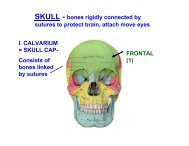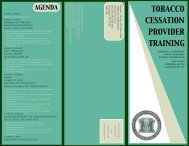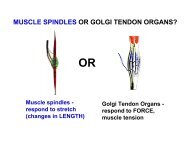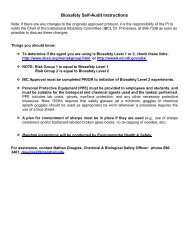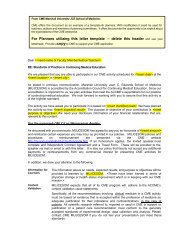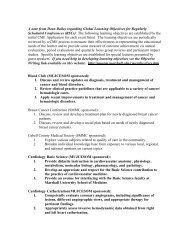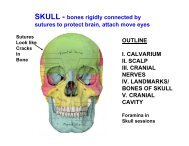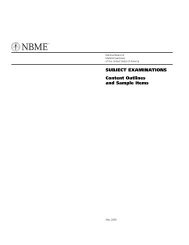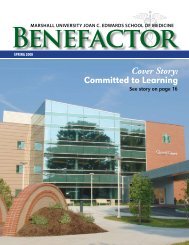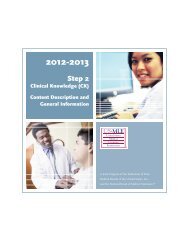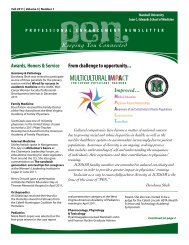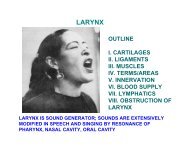FA 5 Progress Report WV-INBRE - Joan C. Edwards School of ...
FA 5 Progress Report WV-INBRE - Joan C. Edwards School of ...
FA 5 Progress Report WV-INBRE - Joan C. Edwards School of ...
- No tags were found...
Create successful ePaper yourself
Turn your PDF publications into a flip-book with our unique Google optimized e-Paper software.
Program Director/Principal Investigator (Last, First, Middle): Rankin, Gary O 64Phenotype #1 (adults)(1) fasting plasma total cholesterol ≥95th percentile for age, sex and race(2) fasting plasma triglycerides ≥ 90th percentile for age, sex and race(3) at least one first degree relative with a different hyperlipidemic phenotype(4) a positive history <strong>of</strong> premature CVD (e.g. myocardial infarction) before age 60Exclusion criteria for probands included (1) diabetes, (2) obesity (BMI 28), (3) tendonxanthomas, (4) evidence <strong>of</strong> defect in LDL receptor gene, and (5) type III hyperlipidemia (certainapoE2/E2 homozygotes). Related family members were designated as affected if they have eitherelevated total cholesterol, elevated triglycerides or positive history <strong>of</strong> CVD.Phenotype #2 (juveniles)(1) fasting total cholesterol ≥95th percentile for age, sex and race(2) fasting triglycerides ≥90th percentile for age, sex and raceSimilar exclusion criteria were used for this phenotypeRe-consent process and database submissionIn Y10, we were advised by Dr. Krishan Arora (our NCRR program <strong>of</strong>ficer) that we would berequired to submit all exome sequence and related clinical data to the database <strong>of</strong> Genotype andPhenotype (dbGAP). This necessitated revision <strong>of</strong> existing IRB protocols and consent forms andre-consent <strong>of</strong> already enrolled family members. Modification <strong>of</strong> IRB protocols at MarshallUniversity, University <strong>of</strong> Kentucky (UK), West Virginia University (<strong>WV</strong>U) and Charleston AreaMedical Center (CAMC) was completed late in Y10. Re-consent <strong>of</strong> participants began late in Y10and continued through Y11. We selected families for whole exome sequencing based oncompletion <strong>of</strong> the re-consent and absence <strong>of</strong> pathogenic mutations in the LDLR gene. CAMC andUK collaborators continued to recruit FCH families in Y11.Sequencing LogisticsLDLR exon sequencing was performed on an ABI3130 Genetic Analyzer by Dr. Jun Fan by the MUGenomics Core Facility. We received and installed an Illumina HiSeq1000 next generationsequencer in March 2011. We received training in the construction <strong>of</strong> libraries and high throughputsequencing in April 2011. Bar-coded whole exome libraries were prepared using the IlluminaTruSeq Exome Enrichment Kits. Whole exomes were sequenced in either 2 x 100 or 2 x 125paired end strategy. In our initial sequencing run, we obtained 3 to 9 million bases per exome (Table1). Quality scores indicate sequencing error rates at ~1 in 10,000 bases and correspond to theexpected error rates for Illumina sequencers. Variants were called by comparison to the humanreference genome (hg19) using Casava 1.8 s<strong>of</strong>tware.Table 1. Sequence data per exome from families 115001, 115021, 115027Family member Total bases (Mbases) % Align (PF) Mean Quality Score (PF) Avg foldcoverage115-001-001 3,732 87.81 36.07 18.29115-001-002 6,242 88.03 35.87 28.22115-001-003 5,920 88.17 35.92 30.54115-001-005 8,958 88.01 36.00 38.05115-001-006 5,508 86.16 35.48 28.60115-001-022 4,868 86.86 35.60 23.78115-001-023 6,462 87.11 35.78 28.84115-001-024 5,232 87.95 35.78 22.96115-001-025 3,008 87.30 35.88 8.13115-021-001 5,324 87.81 36.12 24.25115-021-002 7,022 88.17 36.09 35.55PHS 2590 (Rev. 06/09)Continuation Format Page



